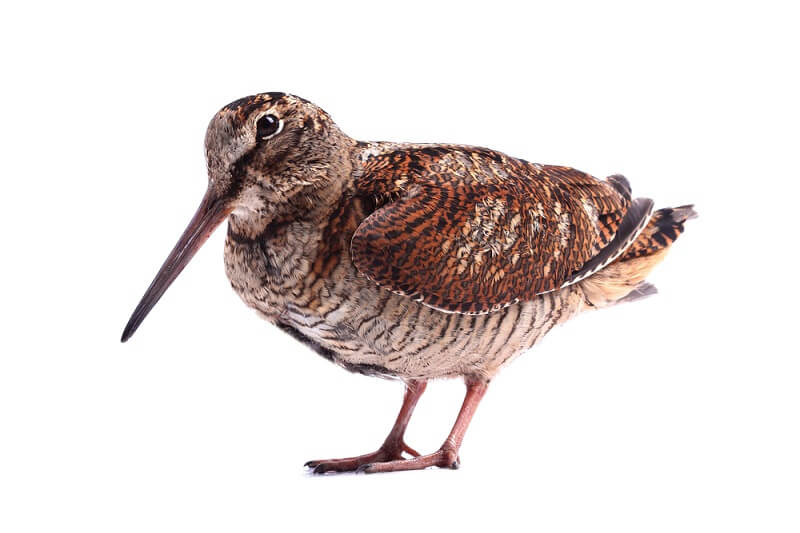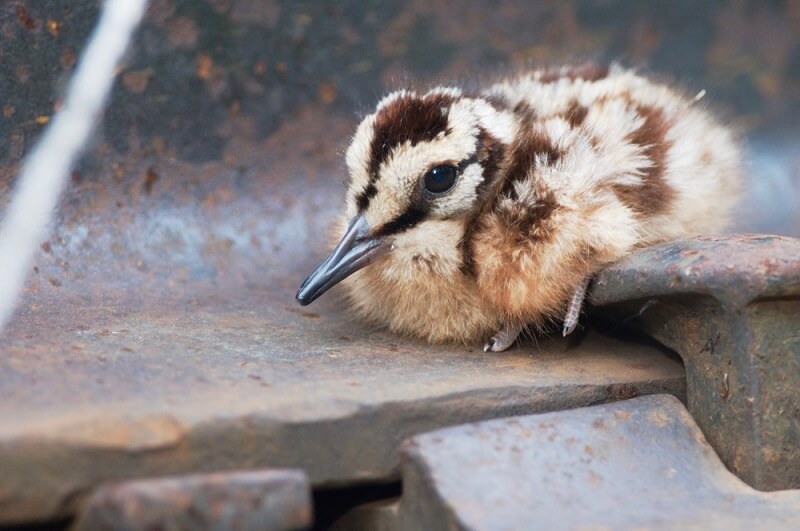
| Kingdom | Animalia |
| Phylum | Chordata |
| Class | Aves |
| Order | Charadriiformes |
| Family | Scolopacidae |
| Genus | Scolopax |
| Species | 8 Different Species |
| Niche | Wading and Digging Insectivore |
| Length | 10-12 in (25-30 cm) |
| Weight | 5-8 oz (140-230 g) |
| Lifespan | Average of 2 years, up to 8 years |
| Social Structure | Small flocks |
| Conservation Status | Least Concern |
| Preferred Habitat | Woodlands, shorelines |
| Average Clutch Size | Around 4 eggs |
| Main Prey Species | Invertebrates buried in the soil or substrate |
| Predators | Canines, felines, larger predatory birds, reptiles and humans |
The Basics
The woodcock is a common name for 8 different species within the Scolopax genus. With a distinctively long, cylindrical, probing beak and complex brown-to-black coloration, the woodcock can easily sneak around the forest floor looking for insects. Closely related to sandpipers and other related species, these birds are well adapted to hunting small invertebrates within the soil and shallow water.
Woodcocks are common throughout many parts, with the American woodcock in North American and the European woodcock expanding from Ireland to Japan and southward to New Guinea. However, the woodcock has adapted to several islands very quickly – rapidly radiating into a number of distinct species that have a very limited range. These include the Amani woodcock as well as several different species spread throughout island nations like Indonesia, the Philippines, and New Guinea.

The woodcock is a mostly ground-dwelling bird. Though they have the ability to fly, they spend most of their time on the ground hunting small insects. Most species also nest on the ground, laying camouflaged eggs that are very hard to find among the leaf litter of a boreal forest. Woodcocks are commonly hunted for their meat and feathers – and in some cases, minor species have almost been wiped out by overharvesting.
Though woodcock species are not known to make loud vocalizations, they do produce a sound by spreading their tail feathers and letting the wind pass through – called ‘drumming’ – that sounds almost like a horse whinny. In fact, it was not until the 1950s that scientists confirmed it was woodcocks and snipes making these sounds.
Interesting Insights from the Woodcock!
While the woodcock has been part of humanity’s folklore and culture for millennia, most people might think the bird is nothing special. But, that couldn’t be further from the truth! The woodcock is an excellent example of several biological concepts that are only seen in a few parts of biology.
Drumming – a non-vocal mating sound
Whereas most birds communicate through sounds created in the throat (vocal), woodcock mating calls are made in the tail feathers. Like other closely-related species, woodcocks have special tailfeathers with a number of ridges. To make the ‘drumming’ noise that sounds like horse whinny, woodcocks fly into the air and dive-bomb the ground. As they gain speed, they spread their tail feathers and the air vibrates the feathers at a high rate. This creates soundwaves with a very distinct quality.

Interestingly, this behavior is not limited to this species. Many other animals, from hummingbirds to crickets, create sound waves outside of their respiratory system. Hummingbirds and doves make noises in a similar way to the woodcock, by allowing air to pass over specially evolved feathers. Within the insects, a much more common way to create sound vibrations is through a process called ‘stridulation’ – the act of rubbing two ribbed surfaces against each other. This is what creates chirping sounds in crickets, hissing noises in tarantulas, and the incredibly loud calls of cicadas.
Ground-Dwelling Birds
The woodcock is one of many ground-dwelling birds. Though making a nest on the ground may seem like it would be less effective than making a nest in a tree, these species have special adaptations that increase the survival chances of their offspring.
One trait that almost all ground-dwelling birds share is camouflaged eggs. Birds like robins that lay build nests in trees often have brightly colored or pure-white eggs. Since very few predators can even access a nest built high in a tree, there is no need to try to hide the eggs using coloration. But for ground-dwelling birds, this is an absolute necessity. Other birds that lay eggs on the ground – like killdeer and plover – also have eggs that easily blend into their surroundings.

Another trait shared by most ground-dwelling birds is precocial young. The term “precocial” means that the chicks are almost fully developed by the time they hatch. Woodcock chicks are born with a full coat of down feathers, can walk within a few hours, and have the ability to chirp and communicate even within the egg. Tree-nesting birds often have vastly underdeveloped young without feathers or the ability to feed themselves.
